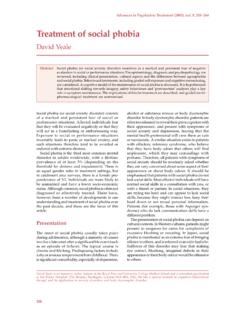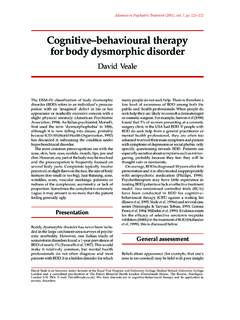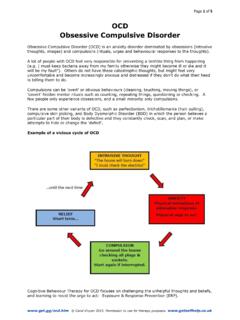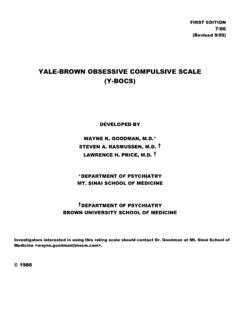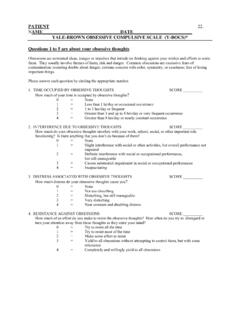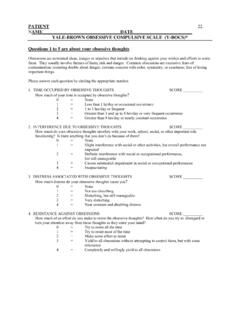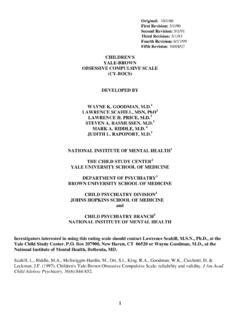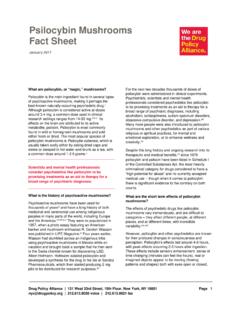Transcription of Cognitive–behavioural therapy for obsessive–compulsive ...
1 438 Advances in Psychiatric Treatment (2007), vol. 13, 438 446 doi: cognitive behavioural therapy (CBT) for obsessive compulsive disorder (OCD) requires a detailed understanding of the phenomenology and the mechanism by which specific cognitive processes and behaviours maintain the symptoms of the disorder. A textbook definition of an obsession is an unwanted intrusive thought, doubt, image or urge that repeatedly enters a person s mind. Obsessions are distressing and ego-dystonic but are acknowledged as originating in the person s mind and as being unreasonable or excessive. A minority are regarded as overvalued ideas (Veale, 2002) and, rarely, delusions. The most common obsessions concern:the prevention of harm to the self or others resulting from contamination ( dirt, germs, bodily fluids or faeces, dangerous chemi-cals) the prevention of harm resulting from making a mistake ( a door not being locked)intrusive religious or blasphemous thoughts intrusive sexual thoughts ( of being a paedophile) intrusive thoughts of violence or aggression ( of stabbing one s baby) the need for order or symmetry.
2 A cognitive behavioural model of OCD begins with the observation that intrusive thoughts, doubts or images are almost universal in the general popu-lation and their content is indistinguishable from that of clinical obsessions (Rachman & de Silva, 1978). An example is the urge to push someone onto a railway track. The difference between a normal intrusive thought and an obsessional thought lies both in the meaning that individuals with OCD attach to the occurrence or content of the intrusions and in their response to the thought or image. Thought action fusion An important cognitive process in OCD is the way thoughts or images become fused with reality. This process is called thought action fusion or magical thinking (Rachman, 1993). Thus, if a person thinks of harming someone, they think that they will act on the thought or might have acted on it in the past. A related process is moral thought action fusion , which is the belief that thinking about a bad action is morally equivalent to doing it.
3 Lastly, there is thought object fusion , which is a belief that objects can become contaminated by catching memories or other people s experiences (Gwilliam et al, 2004). Responsibility One of the core features of OCD is an overinflated sense of responsibility for harm or its prevention. Responsibility is defined here as: The belief that one has power that is pivotal to bring about or prevent subjectively crucial negative outcomes. These out-comes may be actual, that is having consequences in the real world, and/or at a moral level (Salkovskis cognitive behavioural therapy for obsessive compulsive disorderDavid VealeAbstract In the UK, the National Institute for Health and Clinical Excellence s guidelines on obsessive compulsive disorder (OCD) recommend cognitive behavioural therapy , including exposure and response prevention, as an effective treatment for the disorder. This article introduces a cognitive behavioural model of the maintenance of symptoms in OCD.)
4 It discusses the process of engagement and how to develop a formulation to guide the strategies for overcoming the Veale is an honorary senior lecturer at the Institute of Psychiatry, King s College London and a consultant psychiatrist in cognitive behavioural therapy at the South London and Maudsley Trust (Centre for Anxiety disorders and Trauma, The Maudsley Hospital, 99 Denmark Hill, London SE5 8AF. Email: website: ) and the Priory Hospital North London. He is President of the British Association of behavioural and cognitive Psychotherapies, was a member of the National Institute for Health and Clinical Excellence group that produced guidelines on treating obsessive compulsive disorder (OCD) and body dysmorphic disorder (BDD) and runs a national specialist unit at the Bethlem Royal Hospital for refractory OCD and behavioural therapy for OCDA dvances in Psychiatric Treatment (2007), vol.
5 13. behavioural therapy for OCDet al, 1995). The difference in OCD is the individual s appraisal of situations: the belief that harm might occur to the self, a loved one or another vulnerable person through what the individual might do or fail to do. Harm is interpreted in the broadest sense and includes mental suffering; for example, some people with obsessive worries about contamination fear they will go crazy or that the anxiety will go on for ever. Individuals with OCD believe they can and should prevent harm from occurring, which leads to compulsions and avoidance behaviours. Non-specific cognitive biases People with OCD have a number of other cognitive biases (Box 1) that are not necessarily specific to the disorder but, in combination with cognitive fusion and an inflated sense of responsibility, lead to anxiety and compulsive symptoms. The excessively narrow focusing on monitoring for potential threats ( fear of contamination from blood, resulting in constant checking for red marks), even when no immediate threat is present, means that less attention is focused on real events.
6 This reduces the individual s confidence in their memory, which in turn leads to further checking behaviours. Intrusive thoughts, images or urges are often accompanied by an excessive attentional bias on monitoring them. This leads to a heightened cognitive self-consciousness and an increase in the detection of unwanted intrusive thoughts and worries about not performing a compulsion or safety The dominant emotion in an obsession may be difficult for some patients to articulate but it is commonly anxiety. Some also experience disgust, especially when they think that they could have been in contact with a contaminant. Others feel ashamed and condemn themselves for having intrusive thoughts of, for example, a sexual or aggressive nature, that they believe they should not have. Occasionally, a person with OCD believes that they are responsible for a bad event in the past; in such cases, the main emotion is guilt. Many individuals are also depressed, with various secondary problems caused by the handicap; comorbidity with a mood disorder is relatively common.
7 At times, anger, frustration and irritability are prominent. Because of the range of emotions, it is not surprising that some patients find it difficult to articulate and untangle their dominant emotion. Compulsions and safety-seeking behavioursCompulsions are repetitive behaviours or mental acts that a person feels driven to perform. A compulsion can either be overt and observed by others ( checking that a door is locked) or a covert mental act that cannot be observed ( mentally repeating a certain phrase). Covert compulsions are generally more difficult to resist or monitor, as they are portable and easier to perform. The term rumination covers both the obsession and any accompanying mental compulsions and acts. As with obsessions, there are many types of compulsion (Box 2). Early experimental studies established that compulsions, especially cleaning, are reinforcing because they seem to reduce discomfort temporarily.
8 Furthermore they strengthen the belief that, had the compulsion not been carried out, discomfort would have increased and harm may have occurred (or not have been prevented). This increases the urge to perform the compulsion again, and a vicious circle is thus maintained. However, compulsions do not always work by reducing anxiety and are often intermittently reinforcing. Compulsions may function as a means of avoiding discomfort, as in examples of obsessional slowness (Veale, 1993). Box 1 Non-specific cognitive biasesOverestimation of the likelihood that harm will occurBelief in being more vulnerable to dangerIntolerance of uncertainty, ambiguity and changeThe need for controlExcessively narrow focusing of attention to monitor for potential threatsExcessive attentional bias on monitoring intrusive thoughts, images or urgesReduced attention to real events Box 2 The most common compulsionsChecking ( gas taps; reassurance-seeking)Cleaning/washingRepe ating actionsMental compulsions ( special words or prayers repeated in a set manner)Ordering, symmetry or exactnessHoarding Advances in Psychiatric Treatment (2007), vol.
9 13. are usually carried out in a relatively stereotyped way or according to idiosyncratically defined rules. The compulsion to hoard refers to the acquisition of and failure to discard possessions that appear to be useless or of limited value, and to cluttering that prevents the appropriate use of living space (Frost & Hartl, 1996). The individual s criteria for terminating compul-sions are an important factor in their maintenance. Someone without OCD finishes an action such as hand-washing when they can see that their hands are clean; someone with OCD and a fear of contamination finishes not only when they can see that their hands are clean but when they feel comfortable or just right . Others may end a compulsion when they have a perfect memory of an event. These additional criteria for terminating compulsions may cause them to last even longer. Progress in overcoming OCD can be made only when the criteria for terminating a compulsion are restricted to objective criteria.
10 A safety-seeking behaviour is an action taken in a feared situation with the aim of preventing catastrophe and reducing harm (Salkovskis, 1985); it therefore includes compulsions and neutralising behaviours. Neutralising is any voluntary or effort-ful mental action carried out to prevent or minimise harm and anxiety with the goal of either controlling a thought or changing its meaning to prevent negative consequences from occurring ( visualising that the doctor is telling me that I don t have cancer until I feel relief). Other safety-seeking behaviours include mental activities such as trying to be sure of the accuracy of one s memory, trying to reassure oneself and trying to suppress or distract oneself from unacceptable thoughts. Such behaviours may reduce anxiety in the short term but lead to a paradoxical enhancement of the frequency of the thought in a rebound Although avoidance is not part of the definition of OCD, it is an integral part of the disorder and is most commonly seen in fears of contamination.






